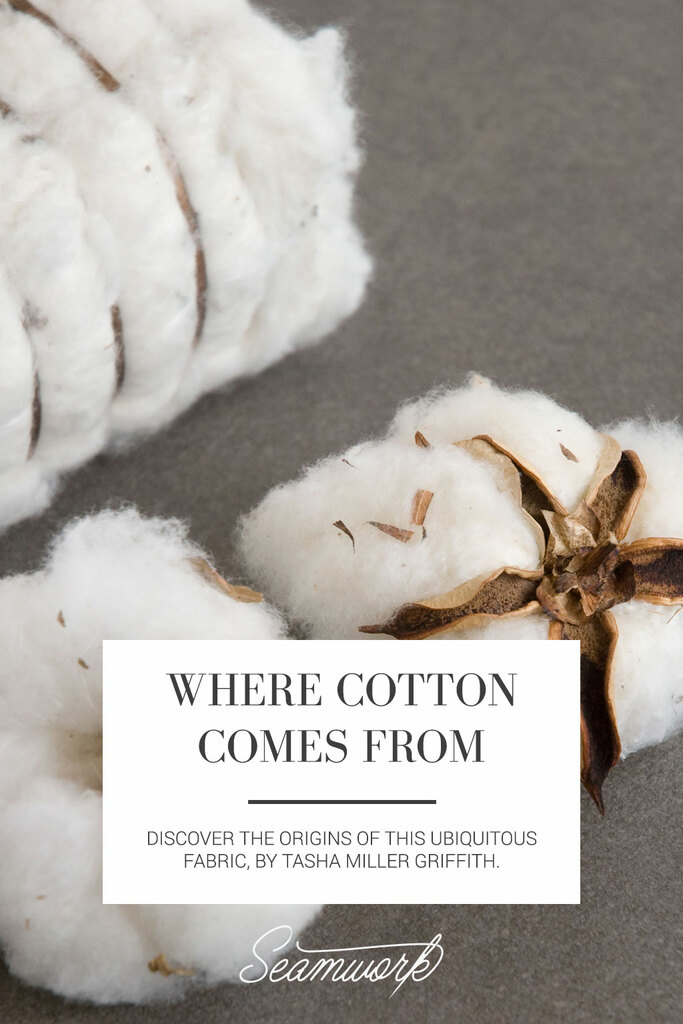“It’s the way that everybody used to farm, our grandparents and all, it’s a way of life that we want to continue with.” –Darlene Vogler, organic cotton farmer.
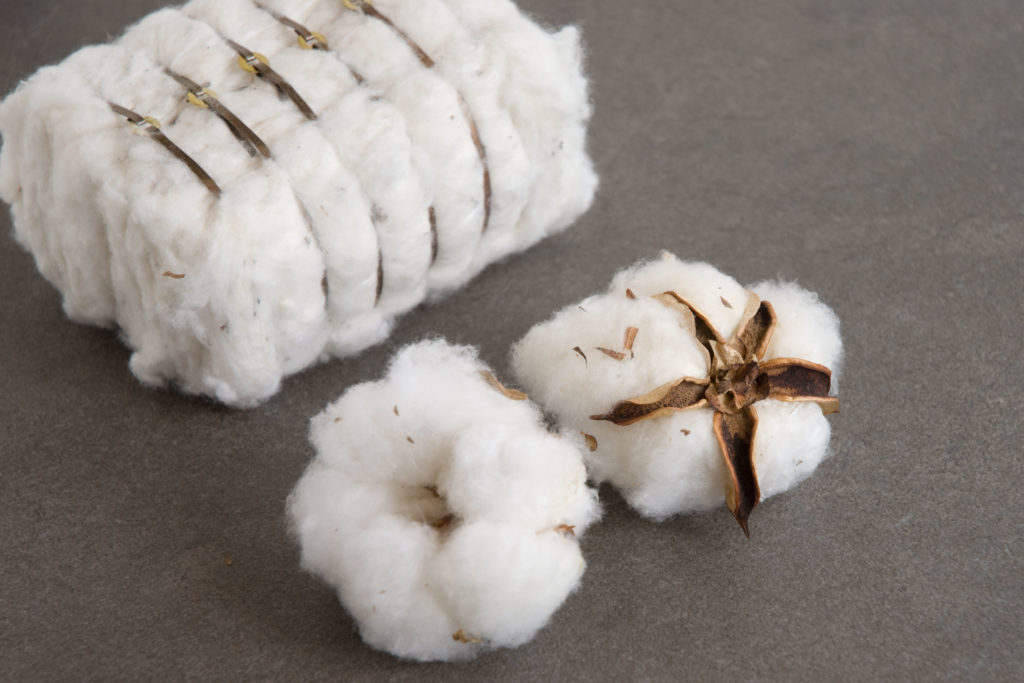
Have you ever thought about where your cotton comes from? If you look down right now, chances are you’re wearing at least one garment that contains cotton in it, down to the thread. I confess I took cotton for granted and didn’t think much about its origins until I participated in 1 Year, 1 Outfit and tried to make a garment from local, sustainable fabrics.
Buying only fabric I could trace to the source (and feel good about) seemed restrictive at first, but I found these limitations allowed me to be more creative, and what I learned and made was so much more satisfying than any off-the-shelf choice. Working with a fabric or yarn where you can imagine the whole journey from farm to your hands makes you feel like you’re not only making something yourself, you’re participating in a whole cycle of life, work, and creativity that links you to the farmers and the land.
Huge changes in the American textile industry over the last few decades have meant that much of our textile growth and production has moved overseas. In spite of these changes, there are still mills in the United States making fabrics from cotton grown here, and a handful of farmers who grow cotton organically. On a recent trip to Texas I got to meet some of those farmers and talk about what it’s like to grow the plants that supply this ubiquitous fiber in a sustainable way. Their story helps us understand where our cotton comes from, its long and sometimes contentious history in the United States, the lives of farmers, how the global marketplace works, and the state of organic cotton farming today.
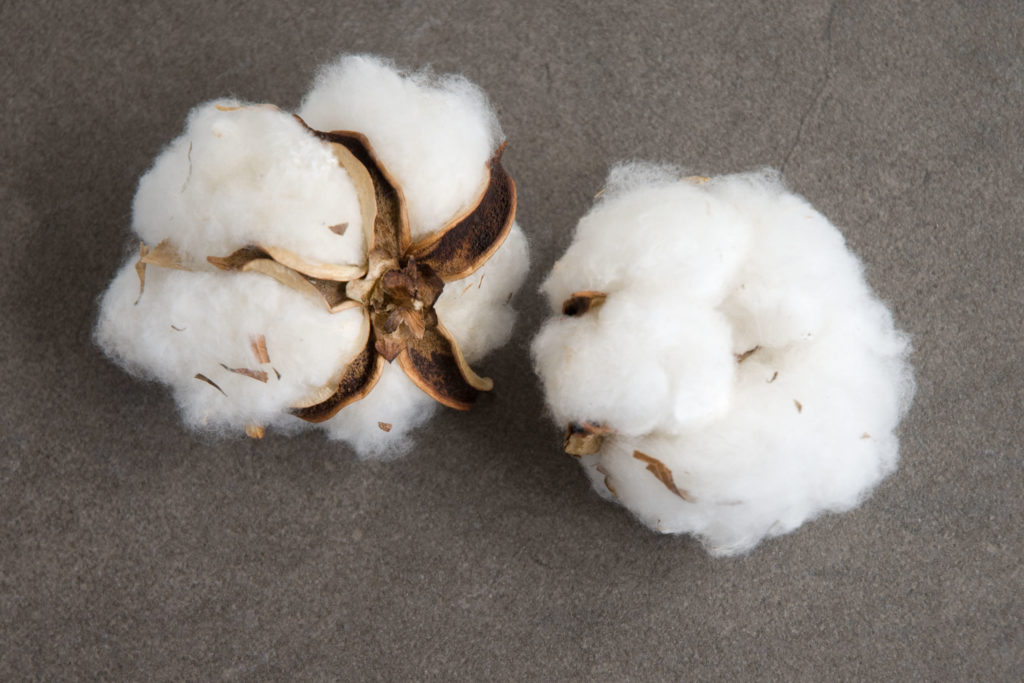
A Brief History of a Controversial Crop
The origins of cotton are somewhat hazy, but it’s clear that there are varieties native to India, Africa, and the Americas. The Old World cotton spread and hybridized with the New World ones long before people from those parts of the world made contact. Two varieties that originated in the Americas are the basis of the worldwide cotton industry today. Gossypium hirsutum, or upland cotton, is relatively easy to grow with high yields per acre, and it accounts for about 95% of the cotton grown around the world today. Gossypium barbadense, which originated in South America, is harder to grow but produces the fine, soft, long-staple fibers we call Pima and Egyptian cotton. When Spanish settlers arrived in the Americas, they found indigenous cultures already growing, spinning, weaving, and dyeing cotton in more sophisticated ways than European cultures were at the time.
Many of the American founding fathers grew cotton on their own farms and processed it at home. Around the time of US independence, British inventors were making machines to process cotton from fiber to fabric on a much larger scale, and thanks to some industrial espionage, the first textile factories soon appeared on the US East Coast as well. Cotton fed the Industrial Revolution in America, leading to both cheaper goods for the masses and deplorable conditions for factory workers. The invention of the famous cotton gin, which separates cotton fibers from the seeds, vastly reduced the hand labor involved in processing. Southern cotton growers latched onto this new invention, increasing their production and bringing vast wealth to themselves and their new country. By 1815 cotton was America’s most valuable export, and by 1840 it was worth more than all other exports combined. However, the growth of cotton plantations also fed the horrific slave trade, as plantation owners sought more slaves to process more cotton, and ultimately led to the Civil War.
Today, the US is still the third-largest producer of cotton in the world, after China and India. Cotton is also still at the center of controversies in our society, even though the controversies have changed. The US now exports about 65% of the cotton we grow, and then imports most of our textiles and apparel, putting cotton in the middle of debates around the benefits of trade versus keeping manufacturing at home. In some places government subsidies even encourage farmers to grow irrigated cotton in the desert, pulling vast amounts of water from rivers and aquifers, and raising debate about water use and agriculture in the face of droughts and a changing climate.
Concerns about chemical use and genetically-modified (GMO) crops exist for cotton as well. According to the National Cotton Council of America, as of 2013 99% of all upland cotton grown in the US was genetically modified to resist insects, herbicides, or both. That means that most of our cotton is sprayed heavily with herbicides (specifically Monsanto’s Roundup), which the cotton plants are engineered to resist but the weeds are not. So much of this chemical is now in the air in cotton-growing areas that some organic farmers list chemical drift from non-organic farms as one of their biggest challenges to a successful crop, second only to weeds. The weeds are now becoming resistant to Roundup as well, and Monsanto has developed new GMO seeds resistant to another herbicide called dicamba. As of this writing, the Environmental Protection Agency is considering approving the use of dicamba on crops of GMO cotton and soybeans.
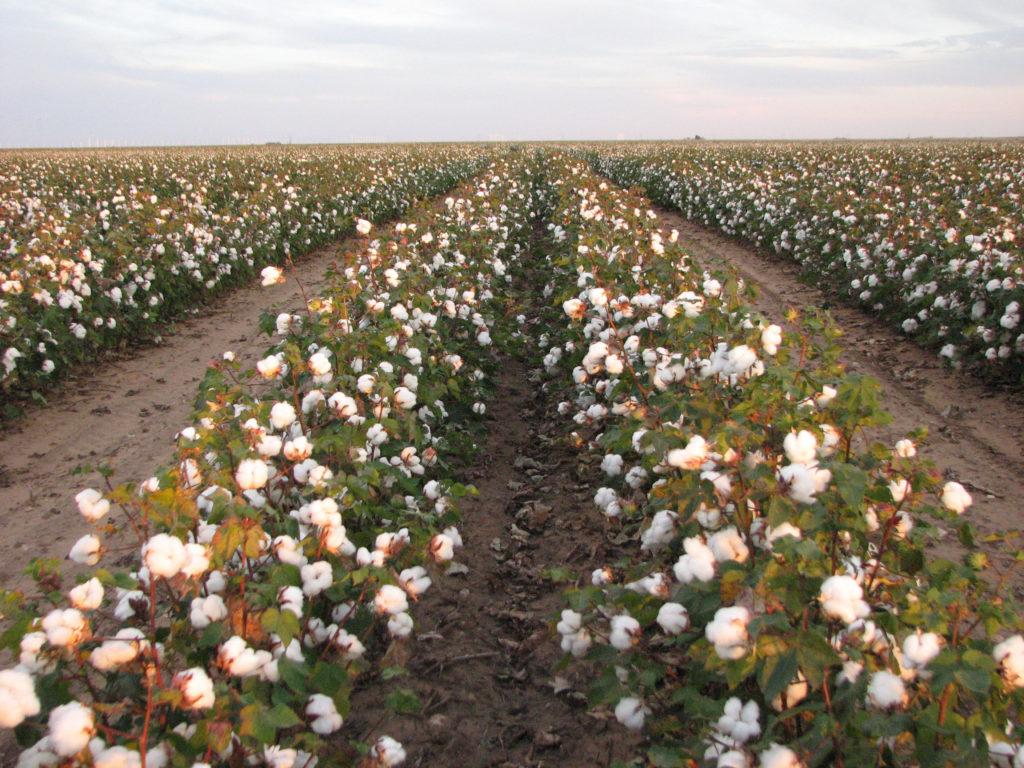
A field of cotton with bolls beginning to open.
Photo courtesy of the Texas Organic Cotton Marketing Cooperative.
Cotton in the Field
In the middle of western Texas is the largest contiguous cotton growing area in the world. In pockets of that area some farmers have chosen a different path, beginning with a few who started experimenting with growing organically in the early 1990s, and who banded together in 1993 to form the Texas Organic Cotton Marketing Cooperative (TOCMC). Around 90% of the organic cotton grown in the US now comes from the 35 or so farmers who make up this group. “This is about the perfect place to grow organic cotton,” says Kelly Pepper of the TOCMC. In most years there is enough rainfall for a good crop, but it’s intermittent enough to let the farmers keep the weeds down, while cool nights keep the insect population low.
Two of the first organic farmers in the Co-op were Jerry and Darlene Vogler, who both come from farming families. “The house that we’re in is where Jerry grew up,” Darlene tells me. “His dad farmed it before him and his granddad, and now our son is taking it over.”
“It’s sure not very glamorous,” Jerry says when I ask what day-to-day life on the farm is like. Like all farmers, he spends a lot of his days doing clean up and maintenance, fixing or improving things around the farm when he’s not tending to the crops. Part of farming organically is rotating crops to keep the soil fertile, so the Voglers have several different things growing in the same season.
The cotton-growing season begins in late spring. Around 70% of the TOCMC farmers have little or no irrigation (a similar percentage to the conventional farms that surround them), so for those farmers it’s a matter of waiting and hoping to get enough rainfall in time to plant, ideally around mid-May to Mid-June, depending on the area. If all goes well, the seeds get in the ground while it’s warm and moist enough to give them a good start.
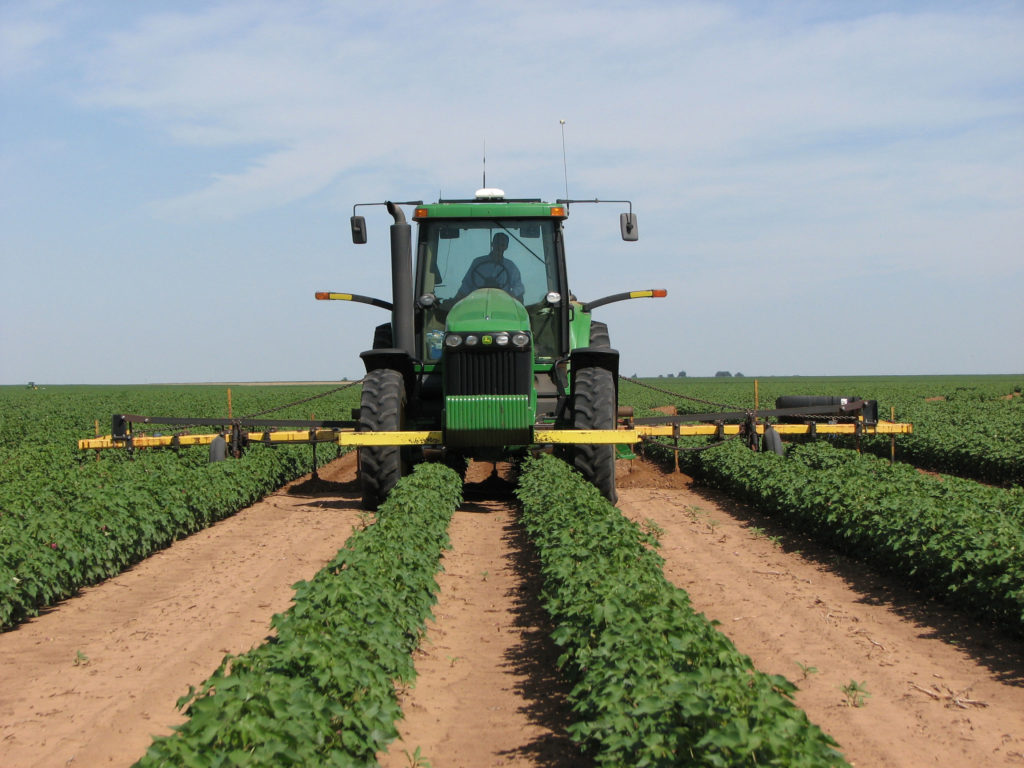
A cultivator turns up the soil, and any weeds, between rows of cotton. Photo courtesy of TOCMC.
“We work harder in the summer—we just have to,” Jerry says. “That’s kind of a drawn-out period in there from mid-June to mid-September that we fight the weeds.” While conventional farms spray their fields with herbicides, the organic farmers take the weeds out mechanically. Although it’s easy to picture an organic farmer planting and pulling weeds by hand, almost all farms in US today are too large for that kind of labor, and organic farms also rely on high-tech machines, and even GPS, to help them farm more efficiently. However, once the plants get bigger, or if the weather conditions don’t permit a cultivator to get in the field within a few days of a rain, they still rely on a crew of people with hoes to take out weeds that could out-compete the cotton.
From Seed to Bale
Cotton plants grow very slowly at first. In mid-summer they form buds (called squares), and begin to bloom around the beginning of August. The bracts around each flower remain after the fertilized flower falls off, and contract to hold the seeds inside, forming a cotton boll. Tightly coiled fibers grow inside, with one end of each attached to a seed. Each day that the boll matures, it grows another layer of cellulose on the inside of the tiny fibers. Eventually the coiled fibers straighten out as the seeds ripen, popping the boll open, and the fibers dry in the sun and air.
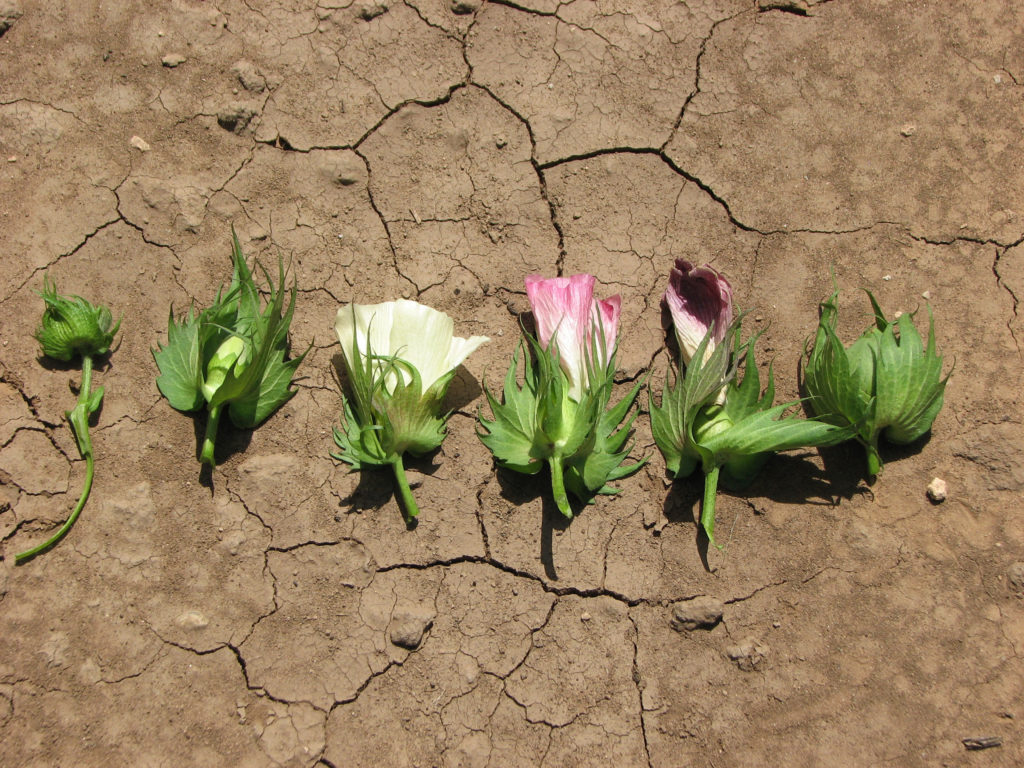
The sequence of cotton blooms from bud through boll. Photo courtesy of TOCMC.
The bolls begin to split open in early October but won’t fully open until after a hard freeze, typically in early November. When they’re ready for harvest, conventional farmers spray their crops with a chemical defoliant that kills the abundant leaves and reveals the cotton pods for picking. Organic farmers instead wait for a frost, which will naturally shrivel the leaves and open the bolls fully. “Ours is variable according to freeze, theirs is more predictable I guess,” Jerry says.
As someone who is a hand spinner who didn’t grow up near growing cotton, I was fascinated by holding a cotton boll and pulling out the fiber. Between one bract and the next is a collection of seeds, tightly packed together, each surrounded by its own halo of wispy fibers. When I think of the work involved in pulling out each seed manually, it’s easy to understand why the cotton gin made such a huge impact.
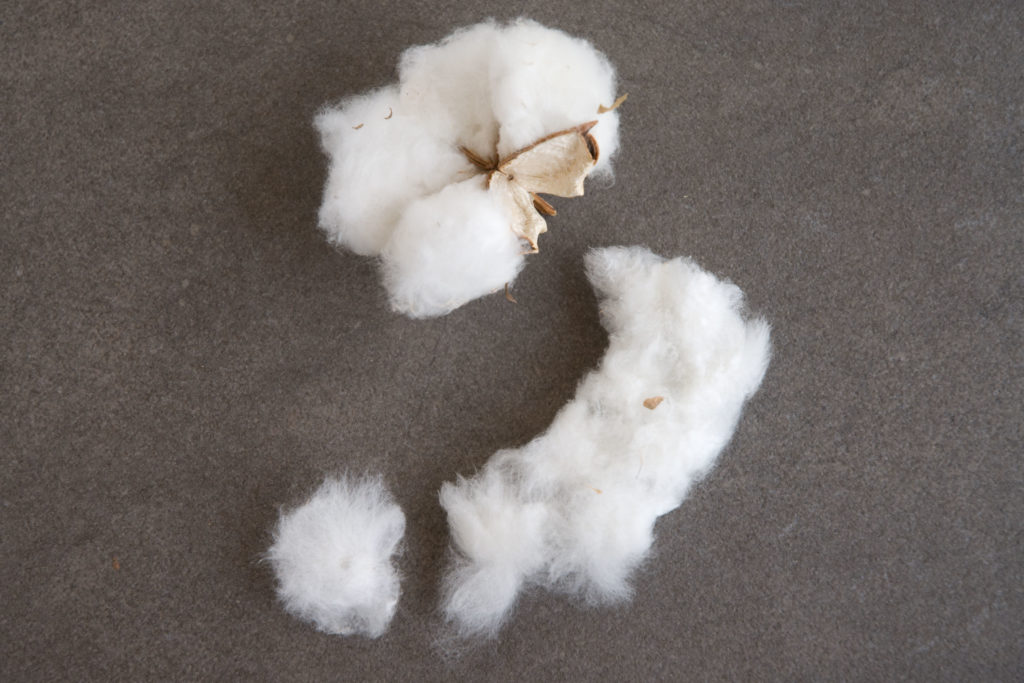
All the seeds in one section of a cotton boll.
Farmers pick the cotton with machines, either a picker (which pulls out the seeds and fibers, leaving the dried bracts intact) or a stripper (which breaks off the whole boll). Either way, the fiber is collected into huge modules in the field, where it waits, covered with tarps, until the cotton gin is ready for it. The gin separates the cotton fibers from the seeds and other plant material, and gathers it again into bales (each weighing about 500 pounds), ready to be sold.
Each batch of cotton is graded for quality at a classing facility run by the US Department of Agriculture. “It’s a much bigger deal for us than it is for a conventional farmer to have high quality cotton,” Darlene points out, since they work more closely with their buyers.
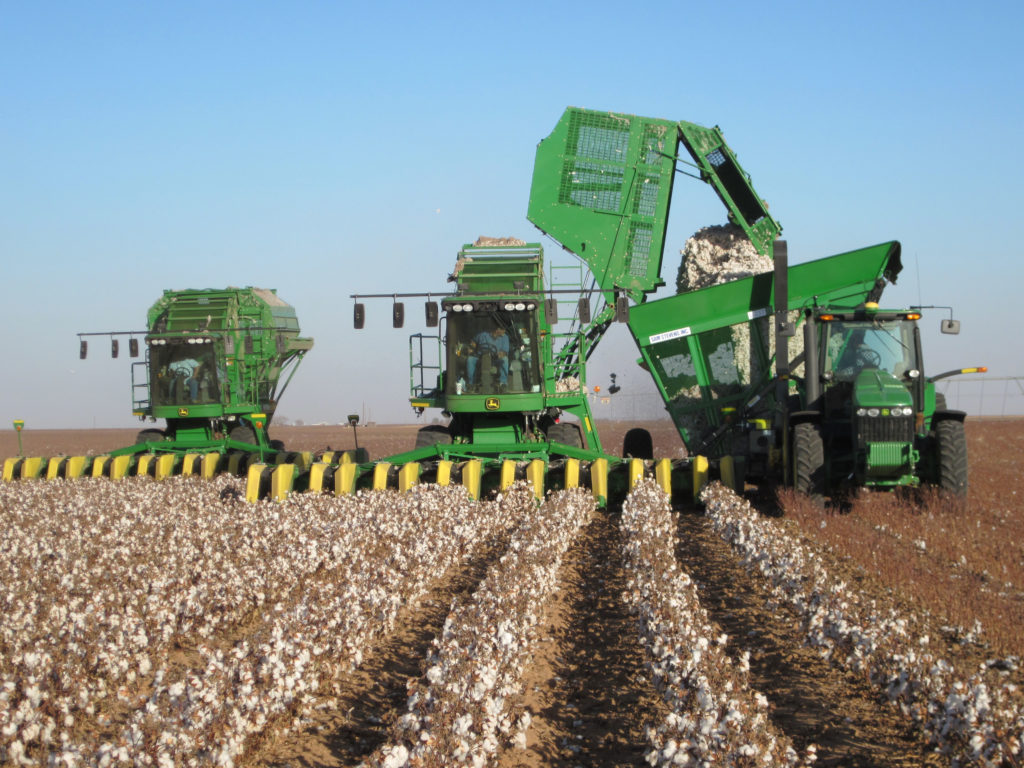
Cotton strippers at work. Photo courtesy of TOCMC.
Risks in the Field
Part of the reason organic cotton costs more than conventional here in the US, which we as consumers often do not think about, is that it’s riskier to grow. All farms face risks of course—it might not rain enough in a given spring to plant cotton at all. But if it rains so much that the plants grow out of control, conventional farmers can spray a chemical to hold back the plants’ growth and cause them to fruit more, while the organic farmers must deal with the plants as they are. At harvest time, the organic pods stand open to the sky—and to potential hailstorms or wind damage—longer, as they wait for the freeze that will make the plants ready for harvest.
“We can’t ever predict what’s going to happen in the future,” Darlene says. No two years are ever the same. Stubbornness has helped to get them through. “It’s our land, we have the right to grow it this way if we want to,” she says.
Cotton in the Market
For a conventional farmer participating in the global cotton market, he or she can drop the harvested fiber off at a gin, where the personnel take bids from buyers. The farmer will agree on a price, and almost certainly will never know what becomes of the crop.
For the Voglers, one of the biggest differences in growing organically has been building partnerships with customers. “The most rewarding aspect—for me at least—has been knowing where our cotton has gone and the people that are using it,” says Darlene. The staff and members of TOCMC work one-on-one with businesses, large and small, to find a market for their products. Their customers believe in using American-grown, organic fiber, and that means that most of it is still milled in the US as well. In the global market, India is now the major world producer of organic cotton. Much of the farming there is still done by hand, at much lower wages than are possible in the US, and Indian farmers do not get a premium for growing organically.
Risks in the Marketplace
On top of the additional risks organic farmers face growing cotton, they also face ups and downs in the market, as well as challenges from unexpected sources. At one point, the Voglers thought they might lose the ability to farm organically when the people in charge of a boll weevil eradication program in Texas wanted to spray every field with insecticide. In the end, the Texas Department of Agriculture overruled the group, telling them they’d have to work with organic farmers and compensate the farmers if their crops were contaminated.
At other times, companies that the TOCMC have worked with have been bought out or ultimately chose cheaper options for their fiber. From 2011 to 2014 Texas suffered varying levels of drought, and the Co-op members struggled to meet demands for their crop. 2015 was a good year for cotton, bringing in the Co-op’s biggest crop ever and leaving them with more bales than buyers.
In spite of the challenges, the Voglers continue to press forward. “It’s the way that everybody used to farm, our grandparents and all, it’s a way of life that we want to continue with,” Darlene says. “We’ve become accustomed to doing this and know that we’re going to be putting in a lot more work, but then we kind of enjoy that too. We feel like it’s better for our health to do it this way, so we’re glad that the market has developed to the point that we’ve been able to make a little living at it all these years.”
No matter what your personal beliefs about global trade, GMOs, or growing organic, I believe that our choices make a difference. Ultimately, everything we buy is a vote for how we want the future to be. As sewists, we’re one step closer to the source, and so we have more choice in what we want to support than the average consumer buying finished garments. The more we know about where our materials come from and what goes into them, the more we can choose the ones that align best with the way we want the world to be. Personally, I hope that as a society we can find ways for cotton to thrive on our soil, and also to be part of a future in which we are all more thoughtful about what we use.
The author sincerely thanks Kelly Pepper at TOCMC for all his help and the use of photos, and farmers Darlene and Jerry Vogler, as well as Jimmy Wedel, for kindly agreeing to be interviewed.
Research sources and further reading:
• The Intentional Spinner by Judith MacKenzie McCuin (a great resource for all kinds of basic fiber information)
• Big Cotton: How a Humble Fiber Created Fortunes, Wrecked Civilizations, and Put America on the Map by Stephen Yafa
Sources of American-grown, organic cotton fabrics for sewists (including those made with cotton grown by TOCMC members):
• Organic Cotton Plus offers a good selection of knits and wovens.
• Organic cotton jersey from Alabama Chanin.
• Sally Fox, a pioneer in growing biodynamic crops and re-introducing naturally colored cottons to the modern market, runs a small online shop with products, including fabrics.
• Sew Eco-Logical is mainly a wholesale business, but they have some smaller cuts of US organic fabric available on Etsy.


